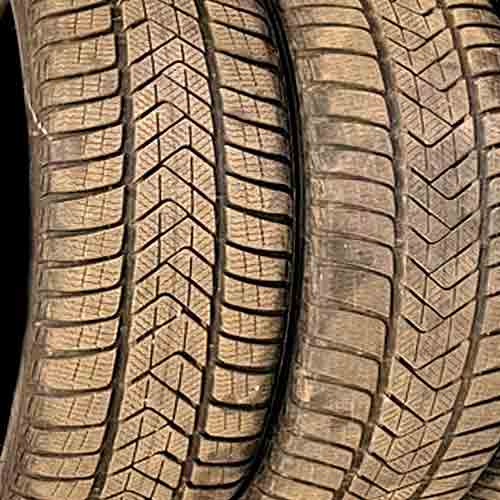Both Pirelli Winter Sottozero 3 and Michelin Alpin 6 are stars in the winter tire world, each providing its own light in the frosty darkness. So its best to consider your needs, when looking at them both.

Key Takeaway
The Pirelli Winter Sottozero 3 (review) outperforms in the following areas:
- Dry Performance: With its compact central rib, the tire ensures continuous road-tire contact during straight-line movement, resulting in superior directional grip. Additionally, its compact shoulder blocks significantly improve handling during cornering.
- Noise Reduction: Its smaller tread gaps and advanced pitch sequencing technology make for a quieter ride, as they effectively limit noise generation from air collisions with the tread.
- Wet Grip: The tire features an assertive siping design and numerous biting edges that attach to wet surfaces effectively, enhancing the tire’s grip on wet surfaces.
On the other hand, the Michelin Alpin 6 excels in:
- Snow Traction: Thanks to its open void design, the tire shows better snow accumulating abilities and better ability to generate forward momentum on snowy surfaces.
- Ride Comfort: The relatively softer tread compound of the Michelin Alpin 6 allows it to absorb road shocks more efficiently, resulting in a smoother ride.
- Hydroplaning Resistance: Its wide grooves and sweeping arms allow the tire to expel water effectively in all directions, ensuring excellent resistance to hydroplaning.
Dry Performance
The level of dry grip can be dictated by 2 things, directional grip, and lateral traction.
Directional Grip
The effectiveness of the directional grip is largely contingent upon the central tread area, which outlines the degree of road-rubber contact. This central zone is subject to the maximum pressure when the tire operates in a straight line.
That’s why the Pirelli Winter Sottozero 3, equipped with a more compact central rib, guarantees constant surface contact during linear motion, resulting in superior performance metrics.
In comparison, the Michelin Alpin 6, despite presenting near continuous rubber to road contact from its middle, isn’t able to provide as much contact, and so it lacks by showing up with 7 feet longer braking distance (on average), on tests.
Handling
The handling characteristics of a tire largely depend on the shoulder areas, as during cornering, the weight on the tire redistributes, and moves towards the tread edges.
That’s why with compact shoulder blocks, the Pirelli Winter Sottozero 3 showcases enhanced performance.
The Michelin Alpin 6 on the other side, not only comes with wider voids towards its edges, but its tread lugs are also more prone to flexing, as the tire turns.
This phenomena of lug bending disrupts the equilibrium between understeer and oversteer, causing the tire to take the back seat when it comes to relative handling performance.
Snow Traction
In snowy conditions, both tires exhibit commendable performance, but still things are slightly better on Michelin Alpin 6.
This is because the tire has a design which incorporates less closed up voids, so it has better snow accumulating abilities, consequently providing a competitive advantage to its rival.
This is because lodged snow sticks better with the snow on the ground (instead of the rubber).
The Pirelli Winter Sottozero 3 on the other hand, not only lacks with closed up voids, but also with less pronounced directional pattern, that permits the tire form properly shovel back as much snow, as its counterpart, to generate forward momentum.
Comfort Levels
Ride comfort is a combination of noise minimization and the tire’s capacity to absorb road irregularities.
The generation of noise in tires is primarily due to the collision of air particles with the tread walls. That’s why its fair to say that, the balder the tire, the louder it gets.
The Pirelli Winter Sottozero 3, with its smaller tread gaps, therefore provides superior noise performance. Furthermore, the tire integrates advanced pitch sequencing technology. Its slight variation in tread block geometries causes air particles to generate different tones upon collision, which ultimately cancel each other out, leading to a quieter ride.
Conversely, the Michelin Alpin 6 although gets to be louder, it still excels in vibration dampening. Its relatively softer tread compound absorbs road shocks more efficiently, resulting in a smoother ride.
Hence, regarding comfort, both tires are rated equal in my books.
Wet Traction
Wet traction primarily rests upon two critical elements: the tread design and the rubber compound. These attributes determine the tire’s adherence on moist surfaces and its capacity to resist hydroplaning. I will address both in details below.
Wet Grip
Despite both tires being heavily siped, the Pirelli Winter Sottozero 3 slightly surpasses its competitor.
This tire basically incorporates a more assertive siping design, featuring a mix of straight and interlocking slits. It also boasts numerous biting edges on its tread that attach to wet surfaces more effectively. These collective characteristics augment the tire’s grip on wet surfaces.
This is because sipes function by expelling air and creating a vacuum that draws in water particles from beneath the tire.
And so Michelin Alping 6 with less aggressive siping lacks in overall handling, its 2 seconds slower on lap times (on average).
Hydroplaning resistance
Hydroplaning, or “floating”, occurs when an insubstantial water layer forms between the tire tread and the road, a consequence of inadequate water dispersal from the tire grooves. Therefore, broader grooves are advantageous.
The Michelin Alpin 6 excels in this department.
Its wide grooves and sweeping arms enable higher average speeds without hydroplaning in both linear and curved aquaplaning scenarios. Its interlinked groove system effectively expels water in all directions, ensuring excellent resistance to hydroplaning.
Summing Up
What conclusions can we draw from the above assessment? The insights are indeed substantial.
The Michelin Alpin 6 emerges as superior in snowy conditions, specifically in fluffy snow, thanks to its unique tread design. However, this same design impedes the tire’s performance on icy and wet terrains.
Additionally, its wide grooves, while augmenting snow traction, mildly compromise the tire’s traction on dry surfaces. Nonetheless, the performance disparity between the two tires under dry conditions is negligible.
Regarding comfort—categorized into noise reduction and vibration absorption—both tires perform commendably. The Michelin Alpin 6 excels in dampening vibrations, while the Pirelli Winter Sottozero 3 stands out in reducing road noise.

